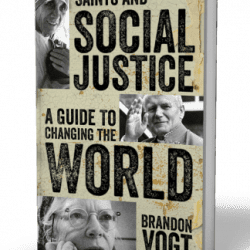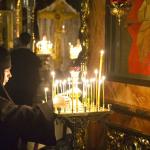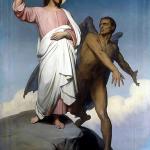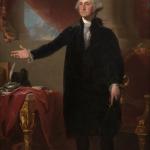 One day as he was grading examinations, J.R.R. Tolkien found one with a blank sheet of paper, whereupon he scribbled down the words, “In a hole in the ground there lived a hobbit.” And so Tolkien began to write The Hobbit.
One day as he was grading examinations, J.R.R. Tolkien found one with a blank sheet of paper, whereupon he scribbled down the words, “In a hole in the ground there lived a hobbit.” And so Tolkien began to write The Hobbit.
That, at least, is the legend. The basic facts are correct, but years later Tolkien would never be certain as to what he exactly wrote down. Nor would he be certain as to when exactly he wrote them down. The original, handwritten text was lost, and all he had was a rough memory of the event. When he would discuss the origins of The Hobbit, he would give this story; mostly, he would use the words as they were eventually published, but sometimes he would suggest other possibilities as being the original opening, such as “At the edge of his hole stood the Hobbit.” For many, this might be pedantic, but for those who are enthralled by the writings of Tolkien and the way his work slowly developed, the two volume set, The History of the Hobbit, edited with notes by John D. Rateliff will be an invaluable addition to their library.
 The History of the Hobbit. Part One: Mr. Baggins. ed. John D. Rateliff (Boston: Houghton Mifflin Company, 2007) shows the creation of The Hobbitfrom the beginning of the story until Lake Town. There are several phases of development, some of them exist only as fragments, some are lengthy drafts of the story, and some are brief notes which Tolkien would write contemplating what should happen next in the story. At times, what we are shown are not surprising to those who have studied Tolkien’s works before: the leader of the dwarves was originally named Gandalf not Thorin, and Gandalf was originally called Bladorthin. At other times, we are given surprises, not only in how developed a portion of the text was in its original draft can be, but also how different the story originally was for Bilbo’s adventures in Mirkwood. Indeed, we see in his original vision what Rateliff calls Tolkien’s “Theseus theme” (pg. 335-39), where Bilbo was to use spider-silk to navigate his way back to the dwarves.
The History of the Hobbit. Part One: Mr. Baggins. ed. John D. Rateliff (Boston: Houghton Mifflin Company, 2007) shows the creation of The Hobbitfrom the beginning of the story until Lake Town. There are several phases of development, some of them exist only as fragments, some are lengthy drafts of the story, and some are brief notes which Tolkien would write contemplating what should happen next in the story. At times, what we are shown are not surprising to those who have studied Tolkien’s works before: the leader of the dwarves was originally named Gandalf not Thorin, and Gandalf was originally called Bladorthin. At other times, we are given surprises, not only in how developed a portion of the text was in its original draft can be, but also how different the story originally was for Bilbo’s adventures in Mirkwood. Indeed, we see in his original vision what Rateliff calls Tolkien’s “Theseus theme” (pg. 335-39), where Bilbo was to use spider-silk to navigate his way back to the dwarves.
 The History of the Hobbit. Part Two: Return to Bag End. ed. John D. Rateliff (Boston: Houghton Mifflin Company, 2007) takes us all the way through the original ending of The Hobbit, only then to return us to the beginning of the story and show how Tolkien changed the text in 1947, and then shows us chapters and notes Tolkien wrote for a completely new telling of the story in 1960. This later version would have had some radical changes to it. He wanted to make the story more compatible with The Lord of the Rings, not only by changing the tone of the narrator, but also by placing more of the world as Tolkien established it in The Lord of the Rings back into The Hobbit (as we can see by the chapters he had rewritten, where we see, for example, a reference to the Prancing Pony at Bree). It was only because a reader of his new text said it was good but no longer The Hobbit that people knew and loved that Tolkien stopped writing his version of the tale. There was no need to do it.
The History of the Hobbit. Part Two: Return to Bag End. ed. John D. Rateliff (Boston: Houghton Mifflin Company, 2007) takes us all the way through the original ending of The Hobbit, only then to return us to the beginning of the story and show how Tolkien changed the text in 1947, and then shows us chapters and notes Tolkien wrote for a completely new telling of the story in 1960. This later version would have had some radical changes to it. He wanted to make the story more compatible with The Lord of the Rings, not only by changing the tone of the narrator, but also by placing more of the world as Tolkien established it in The Lord of the Rings back into The Hobbit (as we can see by the chapters he had rewritten, where we see, for example, a reference to the Prancing Pony at Bree). It was only because a reader of his new text said it was good but no longer The Hobbit that people knew and loved that Tolkien stopped writing his version of the tale. There was no need to do it.
While a book which just gave us these texts would intrigue many Tolkien fans, Rateliff offers us much more. His notes are excellent, and at the end of each section he writes his own commentary, providing important essays on the themes, people, and places of The Hobbit, showing us how and when portions of The Hobbit relates to the whole of Tolkien’s mythology, but also how his story relates to a wider world of philological, philosophical, and literary traditions Tolkien knew and borrowed from. His essays on Riddles (168 – 174), The Ring (174 – 182), The Dolittle Theme (266 – 268), Tolkien’s Dragons (525 – 530), The Arkenstone as Silmaril (603 – 609) and The Battle of Five Armies (713 – 718) were among my personal favorites.
Finally, the appendices at the end of the second volume include interesting tidbits, including a discussion of where Tolkien might have heard the name of “hobbit” before writing down his novel (The Denham Tracts and Tolkien’s Letter to The Observer) and Tolkien’s correspondence with Arthur Ransome (which is of interest because they show what kind of criticism Tolkien was willing to accept over The Hobbit).
It is very difficult to actually rate these volumes. For one who is not a fan of Tolkien, it is unlikely they will find anything in them worth their while. But for those of us who are, they deserve a full 10/10 and are the must-have books of the year.
















